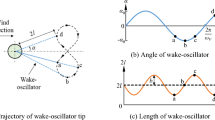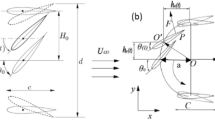Abstract
The dynamic responses of a floating vertical axis wind turbine (VAWT) are assessed on the basis of an aero-hydro-mooring coupled model. The aerodynamic loads on the rotor are acquired with double-multiple stream tube method. First- and second-order wave loads are calculated on the basis of 3D potential theory. The mooring loads are simulated by catenary theory. The coupled model is established, and a numerical code is programmed to investigate the dynamic response of the semi-submersible VAWT. A model test is then conducted, and the numerical code is validated considering the hydrodynamic performance of the floating buoy. The responses of the floating VAWT are studied through the numerical simulation under the sea states of wind and regular/irregular waves. The effects of the second-order wave force on the motions are also investigated. Results show that the slow-drift responses in surge and pitch motions are significantly excited by the second-order wave forces. Furthermore, the effect of foundation motion on aerodynamic loads is examined. The normal and tangential forces of the blades demonstrate a slight increase due to the coupling effect between the buoy motion and the aerodynamic loads.
Similar content being viewed by others
References
API RP-2SK, 2005. Design and Analysis of Station Keeping Systems for Floating Structures. American Petroleum Institute, Washington D.C., USA, 66–67.
Borg, M., and Collu, M., 2015. Frequency-domain characteristics of aerodynamic loads of offshore floating vertical axis wind turbines. Applied Energy, 155: 629–636.
Borg, M., Collu, M., and Kolios, A., 2014a. Offshore floating vertical axis wind turbines, dynamics modelling state of the art. Part II: Mooring line and structural dynamics. Renewable and Sustainable Energy Reviews, 39: 1226–1234.
Borg, M., Shires, A., and Collu, M., 2014b. Offshore floating vertical axis wind turbines, dynamics modelling state of the art. Part I: Aerodynamics. Renewable and Sustainable Energy Reviews, 39: 1214–1225.
Bruinsma, N., Paulsen, B. T., and Jacobsen, N. G., 2018. Validation and application of a fully nonlinear numerical wave tank for simulating floating offshore wind turbines. Ocean Engineering, 147: 647–658.
Cao, H., 2012. Study on the hydrodynamic performance of semi-submersible floating foundation of offshore wind turbine. Master thesis. Tianjin University, Tianjin (in Chinese).
Cheng, Z., Madsen, H. A., Gao, Z., and Moan, T., 2016. Numerical study on aerodynamic damping of floating vertical axis wind turbines. Journal of Physics: Conference Series, 753(10): 102001.
Cheng, Z., Wen, T. R., Ong, M. C., and Wang, K., 2019. Power performance and dynamic responses of a combined floating vertical axis wind turbine and wave energy converter concept. Energy, 171: 190–204.
Collu, M., Brennan, F. P., and Patel, M. H., 2014. Conceptual design of a floating support structure for an offshore vertical axis wind turbine: The lessons learnt. Ships and Offshore Structures, 9(1): 3–21.
Coulling, A. J., Goupee, A. J., Robertson, A. N., Jonkman, J. M., and Dagher, H. J., 2013. Validation of a FAST semi-submersible floating wind turbine numerical model with DeepCwind test data. Journal of Renewable and Sustainable Energy, 5(2): 023116.
Dixon, K., Ferreira, C. J. S., Hofemann, C., Bussel, G. J. W. V., and Kuik, G. A. M. V., 2008. A 3D unsteady panel method for vertical axis wind turbines. The Proceedings of the European Wind Energy Conference & Exhibiti on EWEC Brussels, 6: 1–10.
Dong, X., Lian, J., Wang, H., Yu, T., and Zhao, Y., 2018. Structural vibration monitoring and operational modal analysis of offshore wind turbine structure. Ocean Engineering, 150: 280–297.
Dyachuk, E., and Goude, A., 2015. Simulating dynamic stall effects for vertical axis wind turbines applying a double multiple streamtube model. Energies, 8(2): 1353–1372.
Eriksson, S., Bernhoff, H., and Leijon, M., 2008. Evaluation of different turbine concepts for wind power. Renewable and Sustainable Energy Reviews, 12(5): 1419–1434.
Gao, Y., Li, C., and Cheng, X., 2013. Research on foundation response of a tri-floater offshore wind turbine. IOP Conference Series: Materials Science and Engineering, 52: 052009.
González, J. S., Payán, M. B., and Santos, J. M. R., 2018. Optimal design of neighbouring offshore wind farms: A co-evolutionary approach. Applied Energy, 209: 140–152.
Goude, A., and Bülow, F., 2013. Robust VAWT control system evaluation by coupled aerodynamic and electrical simulations. Renewable Energy, 59: 193–201.
Hall, M., and Goupee, A., 2015. Validation of a lumped-mass mooring line model with DeepCwind semisubmersible model test data. Ocean Engineering, 104: 590–603.
Hall, M., Buckham, B., and Crawford, C., 2014. Evaluating the importance of mooring line model fidelity in floating offshore wind turbine simulations. Wind Energy, 17(12): 1835–1853.
Han, Z., 2016. Design and dynamic analysis of semi-submersible offshore vertical axis wind turbine. Master thesis. Tianjin University, Tianjin (in Chinese).
Hou, P., Enevoldsen, P., Hu, W., Chen, C., and Chen, Z., 2017. Offshore wind farm repowering optimization. Applied Energy, 208: 834–844.
Kumar, R., Raahemifar, K., and Fung, A. S., 2018. A critical review of vertical axis wind turbines for urban applications. Renewable and Sustainable Energy Reviews, 89: 281–291.
Lei, H., Su, J., Bao, Y., Chen, Y., Han, Z., and Zhou, D., 2019. Investigation of wake characteristics for the offshore floating vertical axis wind turbines in pitch and surge motions of platforms. Energy, 166: 471–489.
Lei, H., Zhou, D., Bao, Y., Chen, C., Ma, N., and Han, Z., 2017. Numerical simulations of the unsteady aerodynamics of a floating vertical axis wind turbine in surge motion. Energy, 127: 1–17.
Li, C., 2015. Numerical investigation of a hybrid wave absorption method in 3D numerical wave tank. CMES: Computer Modeling in Engineering & Sciences, 107(2): 125–153.
Li, C., and Liu, Y., 2018. On the weakly nonlinear seakeeping solution near the critical frequency. Journal of Fluid Mechanics, 846: 999–1022.
Li, C., Bryce, K. C., Liu, Y., and Yue, D. K. P., 2019. A fast multi-layer boundary element method for direct numerical simulation of sound propagation in shallow water environments. Journal of Computational Physics, 392: 694–712.
Li, H., Hu, Z., Wang, J., and Meng, X., 2018a. Short-term fatigue analysis for tower base of a spar-type wind turbine under stochastic wind-wave loads. International Journal of Naval Architecture and Ocean Engineering, 10(1): 9–20.
Li, Y., Liu, L., Zhu, Q., Guo, Y., Hu, Z., and Tang, Y., 2018b. Influence of vortex-induced loads on the motion of SPAR-type wind turbine: A coupled aero-hydro-vortex-mooring investigation. Journal of Offshore Mechanics and Arctic Engineering, 140(5): 051903.
Li, Y., Tang, Y., Zhu, Q., Qu, X., Wang, B., and Zhang, R., 2017a. Effects of second-order wave forces and aerodynamic forces on dynamic responses of a TLP-type floating offshore wind turbine considering the set-down motion. Journal of Renewable and Sustainable Energy, 9(6): 63302.
Li, Y., Tang, Y., Zhu, Q., Qu, X., Zhai, J., and Zhang, R., 2017b. Feasibility analysis of floating offshore wind turbine with single point mooring system. The 27th International Ocean and Polar Engineering Conference. San Francisco, California, ISO-PE-I-17-558.
Li, Y., Zhu, Q., Liu, L., and Tang, Y., 2018c. Transient response of a SPAR-type floating offshore wind turbine with fractured mooring lines. Renewable Energy, 122: 576–588.
Liu, L., Guo, Y., Jin, W., and Yuan, R., 2017a. Motion performances of a 5 MW VAWT supported by spar floating foundation with heave plates. ASME 2017 36th International Conference on Ocean, Offshore and Arctic Engineering. American Society of Mechanical Engineers. Trondheim, Norway, OMAE201762625.
Liu, L., Guo, Y., Zhao, H., and Tang, Y., 2017b. Motions of a 5 MW floating VAWT evaluated by numerical simulations and model tests. Ocean Engineering, 144: 21–34.
Liu, S. Y., and Ho, Y. F., 2016. Wind energy applications for Taiwan buildings: What are the challenges and strategies for small wind energy systems exploitation. Renewable and Sustainable Energy Reviews, 59: 39–55.
Liu, Y., Xiao, Q., Incecik, A., Peyrard, C., and Wan, D., 2017c. Establishing a fully coupled CFD analysis tool for floating offshore wind turbines. Renewable Energy, 112: 280–301.
Mandal, A. C., and Burton, J. D., 1994. The effects of dynamic stall and flow curvature on the aerodynamics of darrieus turbines applying the cascade model. Wind Engineering, 18: 267–282.
Masciola, M., Jonkman, J., and Robertson, A., 2013. Implementation of a multisegmented, quasi-static cable model. The Twenty-third International Offshore and Polar Engineering Conference. Anchorage, Alaska, ISOPE-I-13-127.
Murray, J., and Barone, M., 2011. The development of cactus, a wind and marine turbine performance simulation code. The 49th AIAA Aerospace Sciences Meeting Including the New Horizons Forum and Aerospace Exposition. Orlando, Florida, AIAA 2011–147.
Paraschivoiu, I., 2002. Wind Turbine Design: With Emphasis on Darrieus Concept (Chapter 4). Presses internationals Polytechnique. Montreal, Canada, 438pp.
Pegalajar-Jurado, A., Bredmose, H., Borg, M., Straume, J. G., Landbø, T., Andersen, H. S., et al., 2018. State-of-the-art model for the LIFES50+ OO-Star Wind Floater Semi 10 MW floating wind turbine. Journal of Physics: Conference Series, 1104: 012024.
Pinkster, J. A., 1975. Low-frequency phenomena associated with vessels moored at sea. Society of Petroleum Engineers Journal, 15: 487–494.
Salehyar, S., Li, Y., and Zhu, Q., 2017. Fully-coupled time-domain simulations of the response of a floating wind turbine to non-periodic disturbances. Renewable Energy, 111: 214–226.
Shires, A., 2013. Development and evaluation of an aerodynamic model for a novel vertical axis wind turbine concept. Energies, 6(5): 2501–2520.
Tjiu, W., Marnoto, T., Mat, S., Ruslan, M. H., and Sopian, K., 2015. Darrieus vertical axis wind turbine for power generation II: Challenges in HAWT and the opportunity of multimegawatt Darrieus VAWT development. Renewable Energy, 75: 560–571.
Wendler, R., Calderón-Muñoz, W. R., and Leboeuf, R., 2016. Energy-based iteration scheme of the double-multiple stream-tube model in vertical-axis wind turbines. Acta Mechanica, 227(11): 1–9.
Wong, K. H., Chong, W. T., Sukiman, N. L., Poh, S. C., Shiah, Y. C., and Wang, C. T., 2017. Performance enhancements on vertical axis wind turbines using flow augmentation systems: A review. Renewable and Sustainable Energy Reviews, 73: 904–921.
Acknowledgements
The study is supported by the National Natural Science Foundation of China (No. 51879190), and the Tianjin Research Innovation Project for Postgraduate Students (No. 2021YJSB185).
Author information
Authors and Affiliations
Corresponding author
Rights and permissions
About this article
Cite this article
Cui, J., Zhai, Y., Guo, Y. et al. Coupled Time-Domain Investigation on a Vertical Axis Wind Turbine Supported on a Floating Platform. J. Ocean Univ. China 22, 365–376 (2023). https://doi.org/10.1007/s11802-023-5148-x
Received:
Revised:
Accepted:
Published:
Issue Date:
DOI: https://doi.org/10.1007/s11802-023-5148-x




